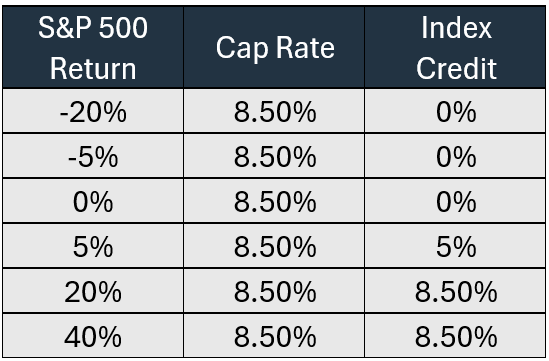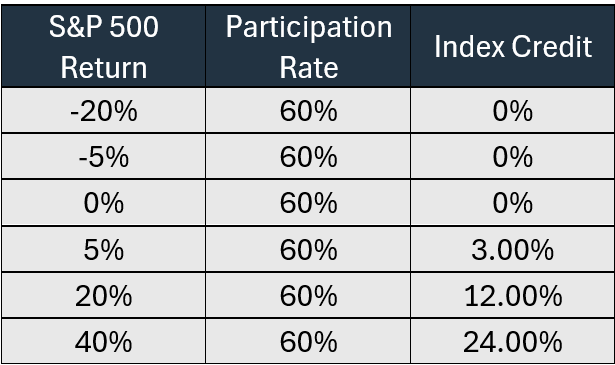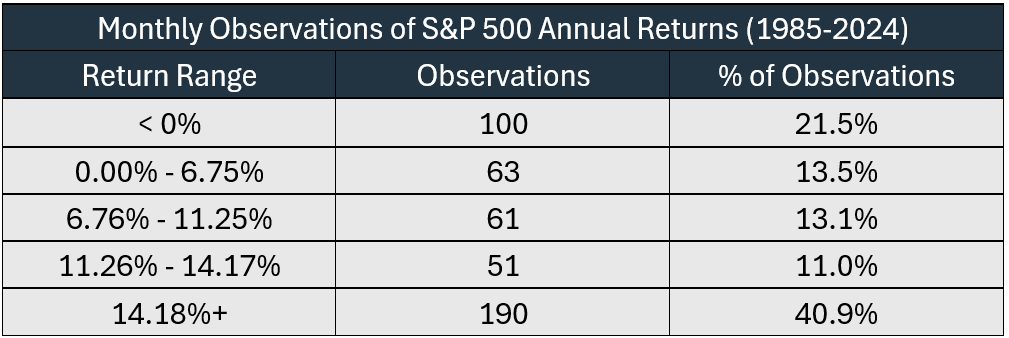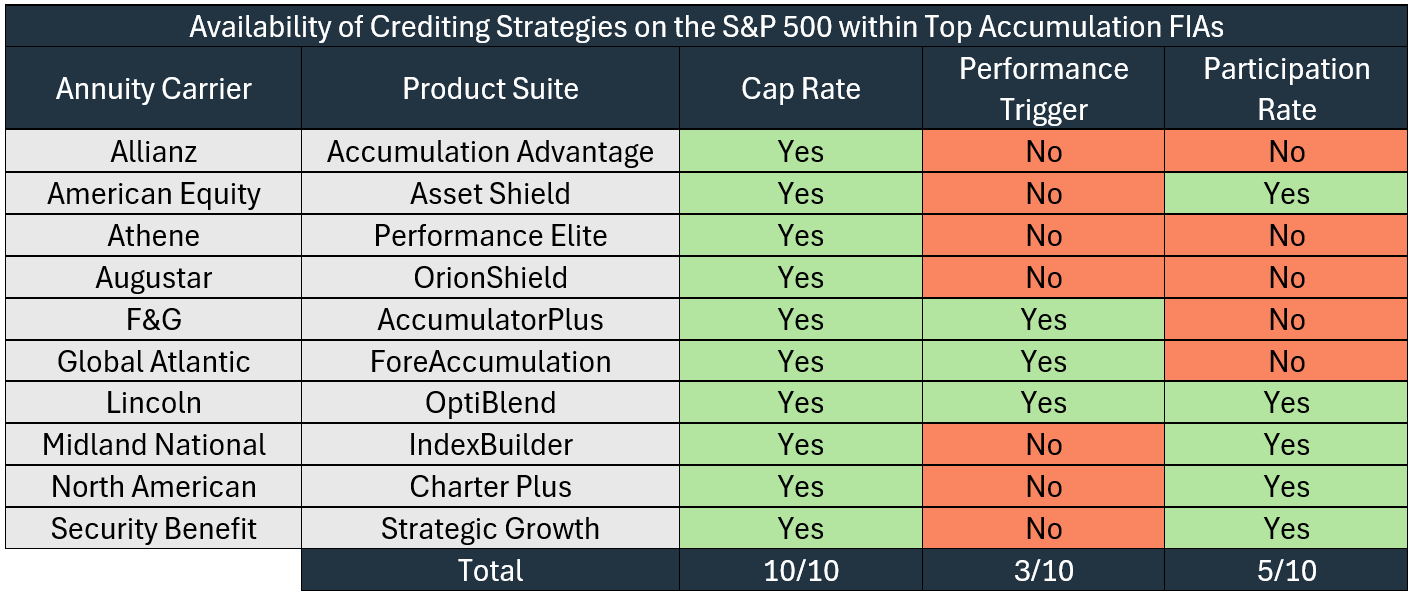Caps and Triggers and Pars – Oh, My!

Policyholders that employ fixed indexed annuities (FIAs) as part of their retirement strategy are staunch believers of the balance FIAs strike between upside potential and principal protection. And as tax-advantaged assets with crediting features that track well-known market indices, FIAs are a common, relatively understandable tool used by many on the yellow brick road to retirement.
On that winding road, policyholders have a host of options available to capitalize on the upside potential of their FIAs. Many choose an option with crediting features linked to the S&P 500, a well-known index that is a bellwether of the American stock market. The index is frequently paired with Cap Rates, Performance Triggers, and Participation Rates to provide different flavors of upside potential for policyholders. With all these options, policyholders and advisors alike are often left asking themselves: which of these S&P 500 crediting strategies will maximize the growth of an FIA?
SPOILER: it depends – on a lot.
A Refresher on Crediting Strategies
Before diving too deep into which crediting strategy might be best, let’s do a quick crash-course on how each of the three crediting strategies work in conjunction with the S&P 500, roughly based on what The Annuity Edge defined as the fair-market rate for each as of 8/28/24.
S&P 500 with Cap Rate
Under a Cap Rate crediting strategy, the investor earns positive performance of the underlying index over the crediting period, up to the Cap Rate. The table below highlights the index credit a policyholder would receive with an 8.50% Cap Rate under a variety of returns.

S&P 500 with Performance Trigger
A Performance Trigger blends the simplicity of the declared crediting rate in a fixed annuity with the index-linked market dependency of an indexed annuity. In a Performance Trigger design, the policyholder receives the declared Trigger Rate as long as the return on the underlying index over the crediting period is positive or zero. If the return on the index is negative at the end of the crediting period, then the policyholder receives no credit.

S&P 500 with Participation Rate
Unlike the first two crediting strategies, Participation Rates offer something uniquely attractive in the FIA market: unlimited upside potential. Policyholders receive an index credit proportional to any positive index performance at the end of the crediting period. In years where the underlying index delivers an extremely strong return, this crediting strategy shines.

A Bet on the Future
What can a policyholder use to decide which crediting strategy will maximize growth? One option is to decide based on a forward-looking prediction of how the S&P 500 will perform. In general, if the S&P 500 remains relatively stable with low single digit growth, a Performance Trigger should perform the best. If the S&P 500 grows by a modest amount, a Cap Rate may provide the best return. If the S&P 500 grows significantly, a Participation Rate will typically win out. The graph below illustrates the winning strategy in a variety of return scenarios, based on the rates previously outlined.

Using fair-market rates (rounded slightly) as of 8/28/2024, we observe the following:
- A 6.75% Performance Trigger delivers the largest credit from returns of 0% to 6.75%.
- A 8.50% Cap performs best from returns of 6.76% to 14.17%.
- A 60% Participation Rate offers the highest upside on returns exceeding 14.18%.

A policyholder that wants to bet on the S&P 500 return falling into one of the ranges has a clear picture of which crediting strategy should be best for them. But what about policyholders that don’t want to make that bet? Though anyone with access to the internet can provide you their well-thought-out* and trustworthy** predictions on which way the S&P 500 will move and how much it will move by, no one has the crystal ball that will tell them exactly what will happen. Is there another option?
*these predictions are rarely well-thought-out
**these predictions are rarely trustworthy
Finding Value by Looking to the Past
Rather than making a forward-looking bet, policyholders can use historical performance to make a decision on which crediting strategy to select within their FIA. In the annuity market, product illustrations are heavily leaned on by advisors to demonstrate the value in how a crediting strategy would have performed historically. Let’s take a similar approach to evaluate the historical performance of these three crediting strategies at their 8/28/24 fair-market rates.
For this exercise, we take a closer look at 465 month-end observations of annual S&P 500 returns dating back to 1985—roughly 40 years’ worth of data during which the index averaged an annual rate of return right around 9%.

What do we notice about the last 40 years of annual returns? It seems that there has been a steady distribution of negative returns, single-digit returns, low double-digit returns, and returns in excess of 20%. However, If we adjust the return ranges to align with the breakpoints where rankings change between the three crediting strategies under the fair-market rates, we start to see a much different picture.

Assuming the fair-market rates from 8/28/2024 applied during each observation (an unrealistic assumption that we’ll talk a little more about later) we can summarize the frequency at which each crediting strategy’s performance would have ranked first, second, or third during each non-negative observation.

In over 50% of the non-negative observations, the S&P 500 annual return exceeded 14.18%: meaning that a 60% Participation Rate would have been the top-performing crediting strategy over an 8.50% Cap Rate and 6.75% Performance Trigger. This overperformance is magnified when annual observations are strung together to produce annualized rate of returns on hypothetical FIAs.



Are Participation Rates on the S&P 500 Undervalued?
A carrier’s S&P 500 Cap Rate is the gold standard in the industry—by far the most benchmarked crediting strategy in FIAs. But based on the data above, it sure looks like policyholders might be leaving some money on the table when hitching their retirement wagon to the limited upside of a Cap Rate.
The reality is, though, carriers don’t set “fair market” rates for all their crediting strategies. For a carrier with an option budget of 4.75%, rather than using a 4.75% option budget to evenly price all crediting strategies, that carrier may arrive at the same overall 4.75% budget by assuming a 50/50 split between the S&P 500 Cap Rate crediting strategy priced with an option budget of 5.00% and the S&P 500 Participation Rate crediting strategy priced with an option budget of just 4.50%. This option budget subsidization allows carriers to get more competitive on their S&P 500 Cap Rate—while introducing additional policyholder behavior risk via the allocations chosen—to vault to the top of rate sheets and draw the most attention.
So, if a carrier isn’t pricing everything to the same option budget, how can a policyholder find relative value among their options? One option is to look at the rate needed to have matched the average annualized rate of return of a given Cap Rate. For a hypothetical 5-year FIA, these are the Participation Rates and Performance Triggers that would have been needed over the last 40 years to match the average annualized return of a given Cap Rate.

Option Cost Volatility
Buckle up, Toto. We’re not in Kansas anymore. Time to (briefly) talk about option costs.
If there’s anything that’s certain about the cost of an option, it’s that the future cost of the same option is uncertain. Between interest rate movements, volatility skew, and fluctuating dividend yields, the cost of a vanilla call option can bounce around chaotically. When it comes to Participation Rate and Cap Rate crediting strategies, however, there’s a difference in their sensitivity to the volatility of these market factors.
A Participation Rate crediting strategy is replicated by the purchase of an at-the-money (ATM) call option. As the cost of that same option fluctuates as the market factors change, there is nothing offsetting the change in cost. A carrier will likely pass along any change in cost (correction: a carrier will likely pass along any INCREASE in cost) back to the policyholder via renewal rates.
A Cap Rate crediting strategy, on the other hand, is replicated by purchasing a similar ATM call option, but also involves the sale of a cheaper out-of-the-money (OTM) call option. By introducing a short position in the additional call option, the replicating portfolio of options dampens the impact of option cost volatility—when the costs of those options move (typically, in the same direction), since the portfolio is long one and short the other, the overall cost of the strategy does not move as dramatically as the sole ATM call option will for the Participation Rate crediting strategy. This difference in sensitivity to option cost volatility between the two crediting strategies, in theory, should lead to more stable renewal rates for Cap Rates. We can look to the impact of parallel shifts in the volatility surface of the S&P 500 for a clear example of this difference:

While parallel shifts in the volatility surface lead to marginal changes in the Fair Market Cap Rate relative to the actual 8/28 surface (99% to 102% of the actual 8/28 Fair Market Cap Rate), there is a much more pronounced impact to the Fair Market Par Rate (83% to 124% of the actual 8/28 Fair Market Par Rate) due to the lack of the second offsetting call option.
Looking Beyond the Average Rate of Return
There’s nothing to hide in the argument that Participation Rates on the S&P 500 are undervalued today. The average rate of return on a historical 5-Year FIA—assuming fair market pricing as of 8/28/24—makes a compelling case for Participation Rates. The same goes for the rate of return at the 25th percentile of historical scenarios, the median of historical scenarios, and the 75th percentile of historical scenarios. In fact, the entire top quartile of historical scenarios for the 60% Participation Rate is better than the absolute best historical scenario for an 8.50% Cap Rate.

Even when stacked up against an inflated, above fair market Cap Rate of 10%, there’s a whole lot to like about a Participation Rate on the S&P 500:

The Role of the Advisor
Advisors are key in the sale of annuities to clients and have a lot of influence over which type of product is sold, which carrier is chosen, and—specifically for FIAs—which crediting strategy money is allocated to. As much as those of us in the industry who are more math-inclined like to think that Participation Rates are simple, they’ll never be as simple as Cap Rates. Which is easier for a potential client to wrap their head around?
“You’ll get the return of the S&P 500 up to 8.50%. In exchange for limiting the upside potential, this product guarantees that you cannot lose money if the return is negative.”
OR
“You’ll get 60% of the return of the S&P 500. So, if the return of the index is 5%, you’ll get 3%. If the return of the index is 10%, you’ll get 6%, and if the return of the index is 20% you’ll get 12%. In exchange for getting less than 100% of the return, this product guarantees that you cannot lose money if the return is negative.”
The old adage “you can’t teach an old dog new tricks” is at play here, too. For advisors that have had success selling Cap Rates on the S&P 500, it’s a lot easier to lean on that success and keep the pitch to a new client as simple as possible rather than muddy the waters with additional options that are slightly more complex and take more time to provide proper education on.
That said, as changes in the market environment and declared renewal rates shift the relative value of available crediting strategies, advisors have an obligation to help their clients grasp the impacts of these changes and participate in making a calculated decision to reallocate or keep the status quo for the next crediting period.
Gaps in the Market
Unfortunately, due to a combination of advisor preference for the Cap Rate crediting strategy and the industry’s acceptance of the Cap Rate on the S&P 500 as the gold standard of a product’s competitiveness, not all carriers provide each of these three crediting strategies as options within their products. Looking at ten of the top accumulation-focused FIAs based on sales volume through the first half of 2024, this reality is evident.

On the S&P 500, only half of the top products offer an uncapped Participation Rate and only 30% offer a Performance Trigger. Only one(!!) of the top ten products offers all three—way to go, Lincoln! Rather than convincing advisors to try and pitch the latest and greatest engineered index that is sure to: 1) backtest extremely well, and 2) confuse a whole lot of clients, why don’t more annuity carriers offer some more optionality on the S&P 500—the most well-known index in the annuity industry—by including a Performance Trigger and a Participation Rate, in addition to a Cap Rate, as available crediting strategies? Annuity carriers owe it to their clients to offer all these crediting strategies on the S&P 500.
In Conclusion
Like all retirement decisions, each individual should align their investment choices with their financial goals and their appetite for uncertainty. Within an FIA, Cap Rates, Participation Rates, and yes, even Performance Triggers will perform better on the S&P 500 in certain market scenarios. While it’s obviously impossible to know which will perform best in the future, that doesn’t mean that clients and advisors can’t have a more informed view of the available options when deciding what to invest in.
In a product category laser-focused on principal protection, upside potential still matters. FIAs are not “set it and forget it” products, though far too many treat them as such. Relative value can consistently be found within the available crediting strategies of an FIA… if you’re willing to look for it.
– Jon Blomquist







